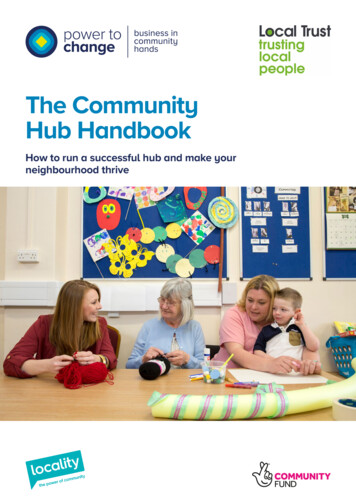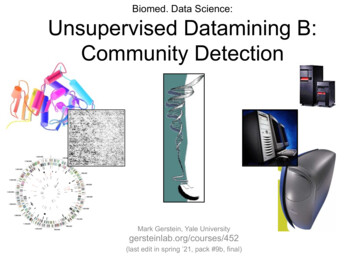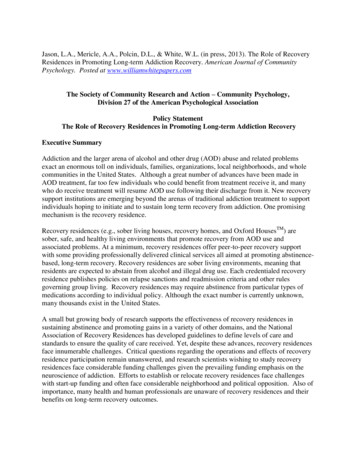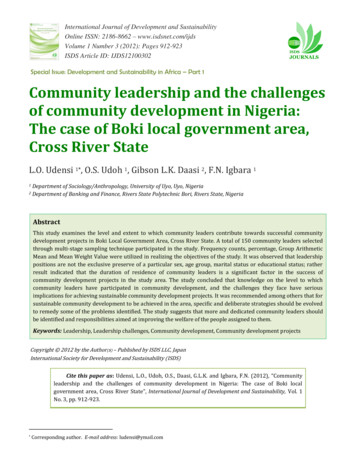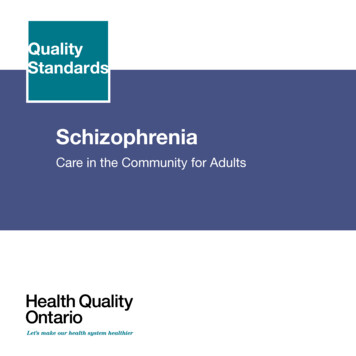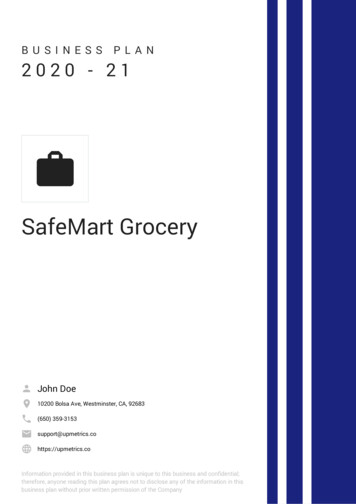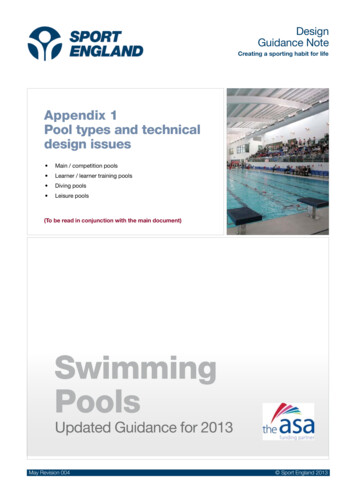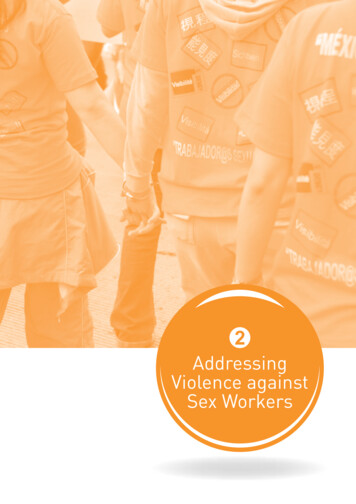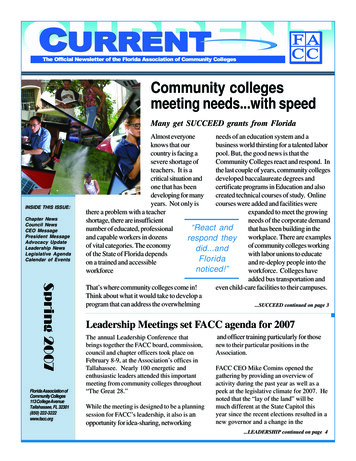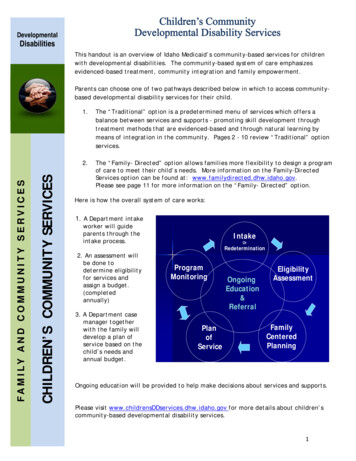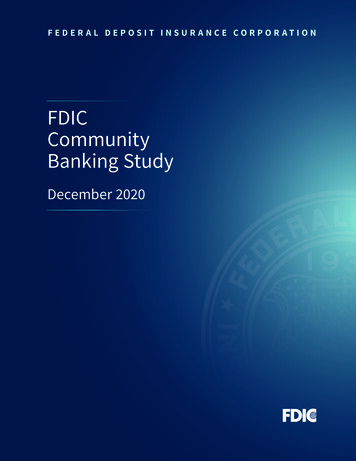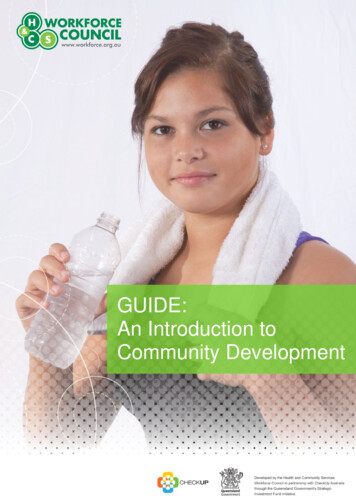
Transcription
GUIDE:An Introduction toCommunity Development
ContentsPurpose of Resource . 3Units of Competency . 3Acknowledgement . 3What is a Community Development? . 4What Community Development is Not. 5Why Does Community Development Matter? . 5A Strategic Framework for Community Development . 8Asset Based Community Development Model . 10Evaluation and Dissemination of Learnings . 11Community Development Case Studies . 12References . 21
Purpose of ResourceThe purpose of this resource is to provide learners with basic information on the principlesof community development and capacity building to support the planning, developmentand implementation of population health initiatives and programs.Trainers may choose to provide this resource as additional supplementary information tosupport learners understanding of community development principles and frameworks andcompletion of relevant assessments.Units of CompetencyThis resource supports learning and completion of assessments for the following units ofcompetency: HLTPOP503C Plan a population health projectHLTPOP505C Build capacity to promote healthCHCCD619B Establish and maintain community, government and businesspartnershipsAcknowledgementThis resource has been adapted from a range of existing resources of which have beenreferenced at the end of this guide.
What is a Community Development?Community development is a conceptual approach to build active and sustainablecommunities in order to enhance community social, economic and environmentalobjectives. In other words, community development is about community members takingthe lead and deciding how they want their community to be and how to make it a betterplace.Community Development is about CommunityMembers Taking the LeadIt is a blend of ‘bottom up’ action that is driven by community. It is about removing thebarriers that prevent people from participating in issues that affect their lives.Community development improves the ability of communities to collectively make betterdecisions about the use of resources such as infrastructure, labour and knowledge.A community development approach can be applied to many different areas includinghealth, education, employment, enterprise development, infrastructure and town planning.
alWhat Community Development is NotTo ensure that the concept of community development is fully understood, it is important tounderstand what community development is not. Community Development is not: a shopping list whereby communities simply set out all the things they want or need;a grant scheme where individuals, organisations and communities apply for royaltyor rent monies;communities making decisions about what they want and organisations going offand making it happen for them, thus building dependence;expecting communities to have all the answers and to solve their problems withoutadditional information, support and resources;working with community leaders and allowing them to make all the decisions to theexclusion of other less powerful community members; ora quick way of making things happen or solving problems.Why Does Community Development Matter?International evidence and examples of community development show that projects aremost effective when they involve the local community they seek to benefit in all aspects ofproject design and implementation.
There are many benefits for using a community development approach including: Developing effective and sustainable initiatives - Active participation ofcommunity members in identifying issues and using their local knowledge, skills andexperience to develop initiatives to address them means that these initiatives aremore likely to be locally appropriate, effective and sustainable.Building community capacity - By participating in all steps of the process andcollectively owning and implementing solutions, community members build theirskills, knowledge and experience which helps them to tackle other issues.Increasing community cohesion - Working together increases communitycohesion as people become aware that they face common issues and worktogether to address them.Empowerment - Community development builds stronger and more self-reliantcommunities that are better able to identify priorities and meet needs and thereforehave greater control over their lives, communities and futures.Multiplying health gains - A focus on community development increases likelihoodthat other people and organisations within health and other sectors will also be ableto promote health. This will multiply health gains many times over.Visibility - A focus on capacity building increases the recognition given to thediverse efforts of practitioners working with others to take on and sustain programs.Responsive systems – Community Development involves a focus on theprocesses that support change within and between organisations. It leads tosystems which value critical problem solving and leadership across organisations.Responsive systems are more likely to work in partnership to address healthchallenges.Addresses inequity – Community development is promoted across government asa mechanism for addressing inequity and building stronger communities throughincreasing community participation.Unifying theme – Community development is not owned by any one sector andtherefore provides a unifying theme under which government departments andother organisations can work together to address inequities.Reorientation of health services – This is one of the main strategies in the OttawaCharter for Health Promotion. The message is that along with treating ill health,health services need also to take greater responsibility for improving the health ofthe communities they serve.Community Development PrinciplesThere is no set process for community development. However there are a number of keyprinciples that guide a successful and effective community development process asfollows:Respect and value pre-existing capacitiesEffective community development allows for exchange of expertise between groups. It isimportant to identify pre-existing skills, structures, partnerships and resources and work
with, and respect these. In addition, programs that are integrated into existing structuresand processes are more likely to be sustained.Develop TrustThe notion of trust is imperative to effective community development. Communitydevelopment is underpinned by trust and respect, and lack of these qualities is often whyso many good initiatives have failed.Be responsive to contextContext refers to the range of physical, economic, political, organisational and culturalenvironments within which a program sits. Context can have a negative or positive impacton a program and is ever changing. Community development practitioners need to beaware of the current context and be ready to respond to changes in context.Avoid pre-packaged ideas and strategiesCommunity development is an approach rather than a set of pre-determined activities.Community development involves approaching each situation separately to identify preexisting capacities and develop strategies relevant to the organisation or the program atthat particular time and place.Develop well planned and integrated strategiesCapacity building needs to work at multiple levels including individuals, groups and acrossorganisations and use a combination of strategies from the action areas of organisationaldevelopment, workforce development, resource allocation, partnerships and leadership.
A Strategic Framework for Community DevelopmentSuccessful community development needs to focus on the following key action areas: Organisational development Workforce development Resource allocation Partnerships LeadershipThe following diagram provides a summary of each of the components of a communitydevelopment framework and suggests strategies for building capacity within each of them.Source: NSW Health 2001, A Framework for Building Capacity to Improve Health, NSWHealth Department, Gladesville, NSW.
Organisational DevelopmentOrganisational development is about ensuring that structures, systems, policies,procedures and practices of an organisation reflect its purpose, role, values and objectivesand ensure that change is managed effectively. Building capacity of an organisation toimprove health is a complex task.There are a number of elements that need to be considered in progressing organisationaldevelopment and change: Environmental context - external factors impacting on the organisations ability tocontribute to the program. Goals - what the organisation wants to achieve, with who, and for whom. Roles - whose job is what to enable the organisation to achieve its goal. Organisational structures, systems and procedures - the way people aresupported to fulfil their roles. Relationships - individuals ability to get along and respect each other.Some examples of organisational development strategies are as follows: Development of policies and strategic plans. Organisational management structures. Management support and commitment. Rewards and recognition systems. Quality improvement systems.Workforce DevelopmentA workforce can refer to both a paid and unpaid workforce within organisations andcommunities. Workforce development is a process initiated within organisations andcommunities in response to the identified strategic priorities to ensure that people have theabilities and commitment to contribute to organisational and community goals.Some examples of workforce development strategies are as follows: On the job learning. Professional development. Opportunities for undergraduate and post-graduate studies. Performance management systems.Resource AllocationResources are those things needed to support a program including people, physicalspace, and administrative support, planning tools, financial support and in-kindcommitment from other organisations or groups.Examples of strategies to enhance resource allocation might include: Lobbying or applying for funding grants. Establishment of core positions to support the program. Ensuring access to expertise when required.
LeadershipWithin a community development approach, organisations are seeking to foster thecharacteristics of leadership within programs and across organisations, by developing andbuilding leadership qualities in themselves and others.Some examples of strategies to build leadership might include: Fostering a personal growth and learning environment. Developing strategic thinking and planning skills. Promote an environment that is creative, innovative and solutions focussed.PartnershipsThe development of effective partnerships to address health problems is importantbecause many of the determinants of health are outside the realm of health services.Partnerships are about capitalising on each organisations unique strengths to worktogether to achieve shared goals.Examples of strategies to build partnerships might include: Identify appropriate partners / services that have shared goals and objectives withthe resources and people necessary to implement initiatives. Invest time to build partnerships and trust between organisations. Ensure measurable project outcomes are meaningful to all partners involved.Asset Based Community Development ModelThere are many different frameworks for building community capacity however one of themost commonly used frameworks is the Asset Base Community Development (ABCD)model. The ABCD is a well developed concept and approach to community developmentthat has been put into practice extensively in the United States. ABCD is a communitydevelopment tool that focuses on identifying and using the assets, talents and strengths inthe community rather than emphasising the problems, needs and deficits. Focusing on thepositive assets will help build the community, giving residents hope and a positive visionfor themselves.It recognises that everyone in the community (including individuals, organisations andbusinesses) has skills, abilities, talents and experience that they can use in order to maketheir community a better place to live. Additionally every community has natural resourcesof space and physical resources.A strong community is built upon identifying and then mobilising its assets.The ABCD model has three key dimensions: Discovering and mapping local assets- a systematic process of identifying anddetailing resources and strengths in the community.o Talents, skills and knowledge of peopleo Strengths, resources and new capacities in our community associations,institutions and businesses
Connecting these assets to work together.o Connections between peopleo Building relationshipso Linking people and their knowledge and skills to community projectso Creating or enhancing relationships between community projects andactivitieso Ideas, solutions and opportunitiesCreating opportunities for these assets to be productive and powerful together.o Take personal action and find shared interests for action with otherso Form strong relationships and partnershipso Solve problems and see new opportunitieso Use what we know to bring in more resourceso Invite others to join ino Create opportunities for the futureThere is no one correct model for running an asset based community developmentprocess. Each community is unique and may progress in different ways and using differenttime frames.The process is basically about answering the following questions: Who are we? What do we have? What do we want? How do we get it?To find out and more information and to get started, visit the Asset Based CommunityDevelopment Institute via http://www.abcdinstitute.orgEvaluation and Dissemination of LearningsEvaluation and dissemination are about learning from practice and sharing this withothers. Sharing the findings with the community is fundamental in the developmentprocess, because of the role they can play in empowering communities and contributing tosocial change.Community development has clear goals and measurable outcomes. These goals andoutcomes should be evaluated and the learnings should be shared widely. Evaluationhelps to assess the effectiveness of community development projects and why they are orare not successful. Evaluation should occur from the beginning of a project and should bea continuous process so that the learnings can inform future planning and development.Evaluation of community development projects should: be a continuous process which is a tool to assist ongoing planning anddevelopment
involve all ‘stakeholders’ and help to answer the questions which are significant tothem.be imaginative and creative, enabling and encouraging all involved to fullyparticipate.be part of accountability to the wider community.highlight and celebrate successes and achievements as well as exploringweaknesses and difficulties.have sufficient resources allocated (including time and money) to be effective.have planned processes for disseminating what has been learnt both withincommunities and more widely.Community Development Case StudiesCase Study 1: Aboriginal Activity Day ProgramOlder Aboriginal people living in the Riverland were not accessing mainstream day careactivities, as they perceived these services to be inappropriate to their needs. The lack ofaccess to services by this group contributed to their social isolation, and was likely to beaffecting their overall health. Evidence shows that for a program to be successful in anAboriginal community, community members should drive it. The involvement of AboriginalElders in the planning not only ensures that the program is culturally appropriate, but alsoprovides them with the sense of ownership and contributes to the sustainability of theprogram.A program of regular activities and outings for older Aboriginal people, based on their inputand assisted by Aboriginal staff, has been established in the Riverland region of SouthAustralia. The objectives of the Aboriginal Day Activity program are to provide a holisticapproach that is culturally appropriate, as well as: Promotes good health and wellbeing. Develops supportive networks. Improves nutrition. Teaches budgeting and diabetic meal preparation. Provides a vehicle for social interaction and activities.The program targets older Aboriginal people who reside in the Riverland region and whoare eligible for Aboriginal Home and Community Care (HACC). The people involved in thisinitiative include the Riverland Regional Health Services Day Activity Coordinator,Aboriginal HACC workers, the Community Services Coordinator and local AboriginalElders.As an initial step, the planners developed a questionnaire that was distributed to existingAboriginal HACC clients and older Aboriginal people, asking if they would like to attend anAboriginal Day Activity Program. Aboriginal HACC workers supported their community toanswer questions and helped the older Aboriginal people complete the questionnaire. Aplanning day was then held to develop a program, utilising the positive feedback from the
questionnaire. The program was set up to include regular outings and existing day activityfacilities were used for in-centre activities. Transport was provided for all participants.The program has not yet been formally evaluated, however, most indicators show that it isachieving its objectives. For example, the number of participants and outings is growing;outings were being held once a month when the program started, however they are nowheld at least twice a month. The regular outings work well, particularly fishing and goingout for lunch. The women also enjoy craft activities that are non-traditional to them, suchas ‘mod podge’ (coupage / bricolage) and teddy bear making.It has been an achievement to conduct a successful and ongoing Aboriginal Day ActivityProgram. It was recognised that employing Aboriginal staff is important in implementing aprogram such as this. The staff help make clients feel comfortable and maintain theculturally appropriate quality of the program. Initially it was thought that clients couldcontribute a small amount of money towards their meals, however this was not the case. Aplanned interstate shopping trip was not successful, also for financial reasons. RecurrentHACC funding and acceptance of the program by Aboriginal clients will sustain theAboriginal Day Activity Program. Social outings and overnight trips are already planned forthe future and the number of participants is increasing.This program has a lot of potential and can easily be adapted and implemented in otherregions with similar Indigenous populations and under similar conditions.Source: Department of Health 2006, Towards a Fairer Society: Community Case Studies.Adelaide: DH (SA).
Case Study 2: Eat Well Outback SAIn 1999 a study titled Eat Well SA: Food Supply in Rural SA investigated the cost, qualityand variety of food supply in shops in rural and remote parts of South Australia (SA). Thestudy found that people living outside of Adelaide and large rural centres generally paidmore for food and had fewer fresh food choices. This was particularly evident in thesmallest towns, the most remote locations, the most socioeconomically disadvantagedareas and places where there were no large shops. In addition, people in some remoteareas needed to shop on or near the day of delivery in order to obtain good qualityproduce.The project undertook a wide range of strategies to address issues of supply, access andfood quality in rural and remote SA. It was based upon the concept of developingcommunity capacity within community groups, schools, stores and health services. Theproject was funded for three years in 2001-2004 by a Federal Department of Health andAgeing grant as part of the National Child Nutrition Program.The aim of Eat Well Outback SA (EWOSA) was to improve food supply and access in ruraland remote SA. The project had five specific objectives, namely to: Increase community awareness and involvement in improving access to healthyfood Advocate for the development of policies that address community identified issuesconcerning the lack of consumption of a healthy diet Collaborate with stakeholders to facilitate improvement of country freight logistics Facilitate the delivery of training to retailers in the region, and the adoption ofeffective store policies, through the development and provision of a HealthyOutback Stores manual Facilitate the delivery of education programs encouraging a healthy diet.The project targeted people living in remote communities in the northern and far-westernregion of the State, particularly stores, Aboriginal communities and schools in these areas.The project partners included the Northern and Far Western Regional Health Service andthe Women’s & Children’s Hospital, with support from the Spencer Gulf Rural HealthSchool. In addition, the following stakeholders were involved in planning and steering theproject: Department of Health (DH) Department of Education and Children’s Services Pika Wiya Health Service Transport Planning Agency Transport SA Spencer Institute of TAFE Australian Competition and Consumer Commission State Retailers Association of SA Whyalla City Council Whyalla Community Health, Whyalla Hospital and Health Service Remote and Isolated Children’s Exercise
Coober Pedy Area SchoolCeduna Area School.The first step was to establish a Project Advisory Group consisting of relevantstakeholders. An experienced Project Officer was employed to liaise with existingcommunity groups and to provide information to the community through a series oftargeted presentations. The Project Officer was able to identify and recruit stakeholdersfrom within the Indigenous community, and to establish partnerships with schools, retailersand health workers. Input was also sought for the development of food safety trainingprograms for outback communities. The Project Officer promoted the project throughconferences, publications and the media.Transport SA’s Transport Planning Agency was approached to discuss the implementationof recommendations from the Country Freight Improvement Study and other freighttransport activities. Relevant retailer freight data was offered to the Transport PlanningAgency for this purpose. The Project Officer also liaised with professional bodies whocould identify training needs and help in the development of a manual to support outbackstores. Contact was made with IGA retailers for further input. A list of appropriateresources was then developed, compiled and adapted for inclusion in the Healthy OutbackStores. Ongoing contact was established with store stakeholders through the provision ofthe Healthy Outback Stores manual. The manual was sent to 19 retailers engaged inEWOSA, and they were also given information about local community initiatives so thatlinkages could be formed at a local level.Schools and communities were invited to identify needs or gaps in existing educationprograms that could be addressed by the project. Specific food needs were also identifiedthrough liaison with regional dieticians, the Pika Wiya Aboriginal Health Service, the DH,local health workers and local retailers. Partnerships were formed to collate and providethe materials and resources to schools, in order to meet these needs. In addition, anexisting program called ‘Creating a Stir’ was adapted and extended in order to meet theneeds of the outback communities. Representatives from ten rural schools were engagedin the project, and each school subsequently received an EWOSA Nutrition and EducationResource Kit.These strategies were based on a health promotion model of: Building supportive environments Using multiple strategies to address a complex issue Working collaboratively with organisations and community groups Building capacity in communities through schools Involving a wide range of sectors to address social and economic determinants ofhealth.Qualitative evaluation of the project was conducted by the Spencer Gulf Rural HealthSchool in 2004. This identified some important outcomes, including demonstrableimprovement in stakeholder knowledge and awareness of nutrition/food issues in the rural
and remote areas involved. There was an increasing sense of community ownership of theaims of the project, and useful collaborative partnerships emerged between serviceproviders, agencies and the community.Progress is being made in the supply and availability of healthy foods in rural areasthrough the involvement of transport personnel. The adoption of primary health careworking practices has successfully been encouraged among regional dieticians.Consultation and engagement with rural and Indigenous communities has also meant thatpeople living in the rural communities have gained knowledge, awareness and skills tomake healthy food choices. A suitable range of targeted educational resources is nowavailable to them.It was widely asserted amongst the stakeholders that the project constituted a practicalattempt to facilitate an integrated intersectoral and inclusive response to a multifacetedand profound health and equity issue. All of the agencies involved were viewed asessential components in identifying and successfully addressing the problems of improvinghealthy food supply andaccess in rural and remote SA.Limited mechanisms are in place to support the project’s sustainability (notably with regardto the compiled resources, their development and wider dissemination). Ongoing activitiesinclude continuing relationships and coordinating mechanisms among the project partners.However, the need for similar ongoing activity in this area, and for someone with the skillsof the Project Officer to be conducting this work, was widely asserted and strongly arguedin the evaluation. The project has laid the groundwork for achieving strategic intersectoraland primary health care activities to improve food access and supply in rural areas.Furthermore, the concept and implementation should be transferable to similarcommunities.It was widely agreed that this work should be further developed by an organisation with aregional focus, however, in order to be successful, the collaboration of a range ofsupporting statewide organisations would also be crucial.This case study is largely based on information written by the EWOBSA Project Officer,Chrissie Hallett, in the EWOBSA Final Report, and Paul Aylward, in the EWOBSAEvaluation Report. Many people were involved in funding, supporting, evaluating andstaffing the project, which was largely managed by Linda Crutchett, Whyalla Hospital andHealth Service.Source: Department of Health 2006, Towards a Fairer Society: Community Case Studies.Adelaide: DH (SA).
Case Study 3: Community ProfilingThe Brucknell Creek Catchment is a small catchment in South West Victoria near thetownship of Warrnambool. The catchment is predominantly rural, with several small townsand a population of approximately 1000. Over the last two and a half years a group ofpeople including local agency representatives and members of the community havegathered to talk about working together in the catchment.The Brucknell Creek Catchment Project has since evolved to adopt a holistic communitydevelopment approach to addressing the social, economic and environmental issues ofthe catchment area. My part in the project has been to develop a Community Profile of theBrucknell Creek Community. The development of the profile occurred over a six-monthperiod from April to September 2003.The main purpose of the Brucknell Creek community profile was to develop a greaterunderstanding of ‘who’ the community is – their characteristics, their story and theirnetworks as well as establish the initial phases in development of relationships with thecommunity. The profile would then be used to form the basis of the CommunityEngagement Plan.The project team was keen to establish a relationship with citizens, explore the level ofdiversity in the Brucknell Creek community and to use this knowledge to develop moreinclusive engagement processes. It was necessary to engage the citizens andstakeholders in the development of the profile because this kind of information had notbeen recorded for this area before (e.g. local history, lists of groups and networks anddescriptions of their interactions with each other, identification of community leaders).Guiding principles of the project:Relationships are critical for successA particular highlight of developing the community profile was the relationships thatdeveloped between myself (the p
positive assets will help build the community, giving residents hope and a positive vision for themselves. It recognises that everyone in the community (including individuals, organisations and businesses) has skills, abilities, talents and experience that they can use
